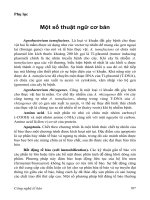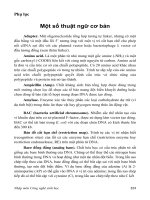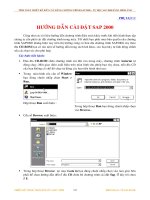Phụ lục C Thuật ngữ pot
Bạn đang xem bản rút gọn của tài liệu. Xem và tải ngay bản đầy đủ của tài liệu tại đây (55.12 KB, 5 trang )
Appendix C
Glossary
Introduction
Microcontroller
I/O pin
Software
Hardware
Simulator
ICE
EPROM Emulator
Assembler
HEX file
List file
Source File
Debugging
ROM, EPROM, EEPROM, FLASH, RAM
Addressing
ASCII
Carry
Code
Byte, Kilobyte, Megabyte
Flag
Interrupt vector or interrupts
Programmer
Product
Introduction
Since all the fields of man's activity are regularly based on adequate and already
adopted terms (through which other notions and definitions become), so in the field
of microcontrollers we can single out some frequently used terms. Ideas are often
connected so that correct understanding of one notion is needed in order to get
acquainted with one or more of the other ideas.
Microcontroller
Microprocessor with peripherals in one electronic component.
I/O pin
External microcontroller's connector pin which can be configured as input or output.
In most cases I/O pin enables a microcontroller to communicate, control or read
information.
Software
Information that microcontroller needs in order to be able to function. Software can
not have any errors if we want the program and a device to function properly.
Software can be written in different languages such as: Basic, C, pascal or
assembler. Physically, that is a file on computer disc.
Hardware
Microcontroller, memory, supply, signal circuits and all components connected with
microcontroller.
The other way of viewing this (especially if it's not working) is, that, hardware is
something you can kick.
Simulator
Software package for PC which simulates the internal function of microcontroller. It is
ideal for checking software routines and all the parts of the code which do not have
over demanding connections with an outside world. Options are installed to watch
the code, movement around the program back and forth step by step, and
debugging.
ICE
ICE (In Circuit Emulator), internal emulator, very useful part of the equipment which
connects a PC instead of microcontroller on a device that is being developed. It
enables software to function on the PC computer, but to appear as if a real
microcontroller exists in the device. ICE enables you to move through program in
real time, to see what is going on in the microcontroller and how it communicates
with an outside world.
EPROM Emulator
EPROM Emulator is a device which does not emulate the entire microcontroller like
ICE emulator, but it only emulates its memory. It is mostly used in microcontrollers
that have external memory. By using it we avoid constant erasing and writing of
EPROM memory.
Assembler
Software package which translates source code into a code which microcontroller can
understand. It contains a section for discovering errors. This part is used when we
debug a program from errors made when program was written.
HEX file
This is a file made by assembler translator when translating a source file, and has a
form "understood" by microcontrollers. A continuation of the file is usually
File_name.HEX where the name HEX file comes from.
List file
This is a file made by assembler translator and it contains all instructions from
source file with addresses and comments programmer has written. This is a very
useful file for keeping track of errors in the program. File extension is LST which is
where its name comes from.
Source File
File written in the language understood by man and assembler translator. By
translating the source file, we get HEX and LIST files.
Debugging
Error made in writing a program, which error we are not aware of. Errors can be
quite simple such as typing errors, and quite complex such as incorrect use of
program language. Assembler will find most of these errors and report them to '.LST'
file. Other errors will need to be searched for by trying it out and watching how
device functions.
ROM, EPROM, EEPROM, FLASH, RAM
Types of memories we meet with microcontroller use. First one can not be erased,
what you write in it once, stays forever, and can not be erased. The second is
erasable with UV lamp. Third one can be erased electrically, using voltage which
microcontroller operates on. Fourth one is electrically erasable, but unlike EEPROM
memory it does not have such a great number of cycles of writing and erasing at
memory locations. Fifth one is fast, but it does not hold back the contents as the
previous when there is supply shortage. Thus, program is not stored in it, but it
serves for different variables and inter-results.
Addressing
Determines and designates certain memory locations.
ASCII
Short for "American Standard Code for Information Interchange". It is widely
accepted type of coding where each number and letter have their eight-bit code.
Carry
Transfer bit connected with arithmetic operations
Code
File, or section of a file which contains program instructions.
Byte, Kilobyte, Megabyte
Terms designating amounts of information. The basic unit is a byte, and it has 8 bits.
Kilobyte has 1024 bytes, and mega byte has 1024 kilobytes.
Flag
Bits from a status register. By their activation, programmer is informed about certain
actions. Program activates its response if necessary.
Interrupt vector or interrupts
Location in microcontroller memory. Microcontroller takes from this location
information about a section of the program that is to be executed as an answer to
some event of interest to programmer and device.
Programmer
Device which makes it possible to write software in microcontroller memory, thus
enabling the microcontroller to work independently. It consists of the hardware
section usually connected with one of the ports and software section used on the
computer as a program.
Product
Product development is a combination of luck and experience. Short terms, or time-
limits for production should be avoided because even with most simple assignments,
much time is needed to develop and improve. When creating a project, we need
time, quiet, logical mind and most importantly, a thorough understanding of
consumer's needs. Typical course in creating a product would have the following
algorithm.









